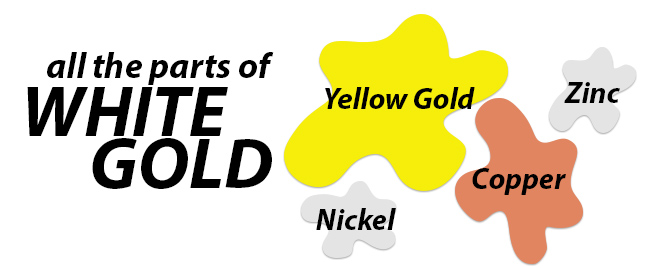11 Apr What is white gold, and why does it turn yellow?
We often get the question “why is my white gold ring turning yellow?” A basic understanding of what white gold is will clear up any misunderstanding of what to expect from your white gold jewelry, and what maintenance your ring will require over time.
The first thing is, there is no such thing as “white gold” in nature – all gold that comes from the ground is 100% “yellow”. Since the standard gold content amount for fine jewelry sold in the United States is 14k, here is one of the various formulas for 14k white gold:

58.5% Gold (yellow) + 23.7% Copper (pinkish-red) + 8.8% Zinc (white) + 9.0% Nickel (white) = 100%
So you can see the majority of your white gold is actually not white but a combination of at least 3 colors of different metals. So it is nearly impossible to make it white, and it will always have at least some yellowish cast to it. The added metals are referred to as “alloy” and are used in different combinations to create the different colors such as “rose gold”, “green gold” , “yellow gold” and “white gold”, as well as to add strength and create durability. Even within the basic gold colors, there are choices of different shades of color like royal yellow, rich yellow, and lemon yellow. To make things even more complicated is the fact that the formulas are not always “industry standard”, and any combination can be used as long as 58.5% of yellow gold is being used.
But let’s get back to why your white gold ring looks yellow…especially when it started out bright white. The majority of white gold jewelry you will ever see starts out with the “addition” of Rhodium plating. I say “addition” because the white gold is real gold, but then made white, and even after that, it is rhodium plated before it is ever put out for sale. That doesn’t mean that it wasn’t really gold to begin with, it just means that the chosen color is then protected as a finish. Over time, and after regular wearing and rubbing against clothing, and other light abrasions, the protective plating of the rhodium wears off, and also the “alloy” portions of the chosen color may begin to slightly oxidize, otherwise known as “tarnish”. Rhodium is a precious heavy metal just like gold, silver, and platinum, and is even part of the platinum family, so it is naturally “white”, and that is why jewelers like to use it for the finishing process.
On average rings wear the fastest and usually need to be re-plated once per year, while earrings and pendants seldom need any unless a repair has been performed. The process usually takes 2-3 days and includes cleaning, polishing, and any stone tightening it may need.

